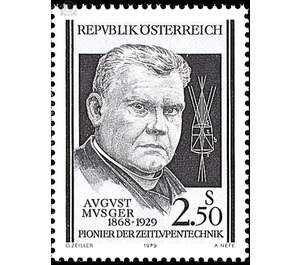50th anniversary of death - Austria / II. Republic of Austria 1979 - 2.50 Shilling
Theme: Well-known people
| Country | Austria / II. Republic of Austria |
| Issue Date | 1979 |
| Face Value | 2.50 |
| Color | black |
| Printing Type | combination printing |
| Stamp Type | Commemorative |
| Item Type | Stamp |
| Chronological Issue Number | 971 |
| Chronological Chapter | OOS-OE2 |
| SID | 831276 |
| In 59 Wishlists | |
In 1979, the 50th anniversary of the death of August Musger. He is considered a pioneer in the development of the technical prerequisite for the "slow motion". Musger was born on February 10, 1868, the son of a teacher in Eisenerz in Styria. After graduation, he studied theology at the University of Graz and was ordained a priest on July 20, 1890. In 1891 Musger came as Kaplan in the western Styrian Peding, devoted himself to his pastoral duties and the study of mathematics and physics. In 1893 he was called to the minor seminary in Graz, where he worked as a professor until his death on October 30, 1929. In his free time, he mainly dealt with physical problems. Among other things, he sought a way to achieve a general improvement in the performance of moving images. The effect of a cinema image is based on the fact that for the human eye, images that follow each other faster than a tenth of a second merge into a moving image. In the course of his work in this area, he came across the phenomenon of slow motion and developed the so-called "serial apparatus with mirror wheel". Building on this invention 1914 was developed by the German company Ernemann a recording camera, which is to be regarded as the first slow-motion camera.


